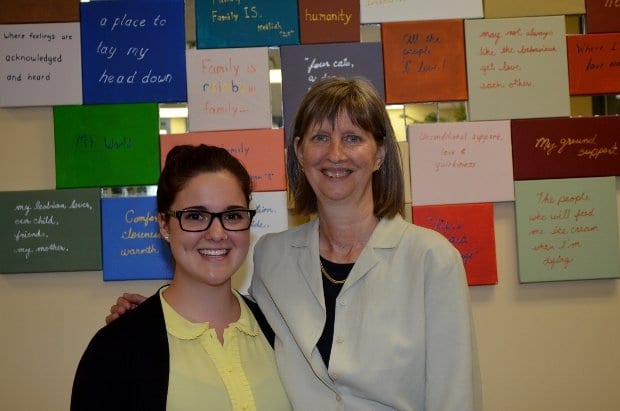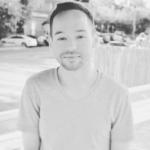A recent Carleton University graduate presented a comprehensive research study examining the needs and challenges faced by children of gay and trans families at Family Services Ottawa (FSO) June 20.
Sophie Clarke says her motivation for delving into this area is personal. She was born into a heterosexual family, but when Clarke was nine her mother came out as a lesbian and became involved with another woman. They lived in a rural town outside Toronto; Clarke says she felt her personal experience was invisible to her peers as she did not see herself “represented in anything that was going on around” her.
Clarke’s study, titled “Queerspawn Experiences: The Challenges and Needs of Youth and Young Adults from LGBTQ+ Families,” pulls from several existing sources, including Abigail Garner’s book Families Like Mine and Let’s Get This Straight: The Ultimate Handbook for Youth with LGBTQ Parents, by Tina Fakhrid-Deen.
Clarke, who identifies as straight, says she hopes “to expand FSO’s capacity serving this particular population, as well as act as a foundation upon which to base and build further research initiatives in this area.”
The invisibility and exclusion Clarke felt growing up is one of the key challenges “queerspawn” face, she says.
Many children of queer families feel safer keeping the non-traditional composition of their families secret to avoid harassment, she said in her presentation.
“Yet this type of invisibility, although sometimes absolutely necessary, can lead to further isolation and exclusion. Not being able to express one’s true self or be open to one’s true experiences can lead to feelings of invisibility, especially when one’s story isn’t automatically represented in the common narratives around them,” she said, noting that trans invisibility is more extreme.
Clarke found that one of the most prominent challenges children of queer families face is external judgment and prejudice. This challenge is compounded by adolescence, but, she added, as these children age, “this fear usually dissipates due to maturity and increased confidence.”
The process of “coming out” as “queerspawn” is parallel to the challenge of coming out as gay, she said.
Those who do choose to come out usually end up falling into the roles of “educator, advocate or defender,” which directly bleeds into another challenge: defending one’s family.
Although some children of queer families may be harassed, many of their peers are more curious or bewildered than hostile, Clarke said.
“This reaction can be positive, as it is not the reaction queerspawn anticipate, but it can also have detrimental effects, as it places the youth in the educator or advocate role. These youth feel a sense of duty to educate others about being from a queer family, and this is a lot of pressure to put on one person,” she said. “It should not be the responsibility of the queerspawn to explain their family’s right to exist.”
This responsibility can lead to some children feeling the need to be perfect, which is a main challenge, she said. “External judgment and prejudice toward queer families can often manifest as a very real pressure. There is a definite sense among some queerspawn that they must somehow prove the legitimacy of their families and of their parents’ ability to raise children effectively.”
Living a bicultural existence, where children can feel as though they are not welcome in the straight or the gay community, is another major challenge.
But family support can help ease a lot of these challenges, Clarke said. It is crucial that queer families allow their children to discuss the challenge of navigating heteronormativity and queerphobia, she emphasized.
She also thinks specific language to reflect the experiences of children from queer families — such as the term queerspawn — can facilitate discussion.
Alisa McClain, of Youth Services Bureau (YSB), attended Clarke’s presentation and says she hopes to implement changes to YSB’s Spectrum youth group to allow children of queer families to have a space in Ottawa’s queer community.
“We are an LGBTQ drop-in, but it doesn’t overtly state that queerspawn are welcome, and I think that we as an agency would want to be really accessible,” McClain says.
But it’s not just about overt language, she says.
“I think the needs of queer youth and queerspawn are very similar. Also, on a personal level, as my children grow up, I want to make sure that there are lots of spaces for them to feel supported and included and have those challenges mitigated for them.”
Clarke also encouraged children of queer families to connect with each other. “A sense of community is key,” she said.
Clarke surveyed queer services in Ottawa to gauge how welcoming our city is. As the internet is the most common resource for youth, she searched terms such as “gay families Ottawa” and “queer family support Ottawa” and said her results were abysmal.
“When services are offered to, or inclusive of, queerspawn, this should be made clear,” she suggested.
Camp Ten Oaks, which has served queer youth and children from queer families since 2005, already makes it clear. The camp also offers Project Acorn for queer children and children from queer families between the ages of 16 and 25.
Hannah Biancardi, volunteer and programs manager for Camp Ten Oaks, attended Clarke’s presentation and says she would like to see her program expand to offer programming year round.
“There’s a lot of services in Ottawa who are very welcoming and would be very wonderful for queerspawn,” Biancardi says. “It’s just about how it’s advertised and framed.”
Laurie Rektor, community programs director at FSO, says her organization will examine Clarke’s recommendations in the future, once her report is made public.
“We purposely decided not to do the recommendations as part of this presentation because it’s kind of looking inward. We don’t want to speak to the community about what we’re going to do as an agency,” Rektor says. “I’m looking forward to seeing what it means for our programs.”
Clarke’s study was made possible by FSO’s Stuart Peterson Fund, which supports students conducting research relevant to services offered by FSO. Previous projects commissioned by the fund include art therapy as a method to cope with mental health challenges and a mental-health questionnaire.


 Why you can trust Xtra
Why you can trust Xtra


